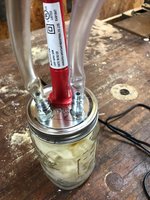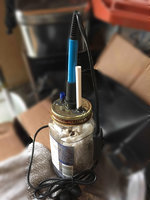As part of troubleshooting issues on my 500SL M119 engine I thought the issue might be a vacuum leak. In order to figure this out I explored getting a smoke generator to pump smoke into the intake to see where any smoke escaped. There are several options from buying a new one starting at $100 to building your own. The DIY options appealed to me and I then looked at different options. These varied from paint cans where air is pumped through after a flaming rag is thrown into the can to wicks wrapped in resistance wires, soaked in mineral oil and hooked up to a battery.
The option I chose was simple, effective and not expensive at all. It consists of a Ball canning jar with a soldering iron epoxied into the lid, two air hose fittings screwed into the lid and also epoxied in. The jar then had cotton fabric inserted into the jar (old T-Shirt and use only cotton) and soaked with mineral oil. Then some clear tubing is attached to the inlet and outlet of the jar and the soldering iron is plugged in. It just takes a few minutes to start generating smoke. I hooked the inlet line to my air compressor and turned the pressure WAAaaaayy down. Too much flow pushes more smoke out than can be generated and it just take a very small amount of air.
The discharge end is then attached to a line going into the intake manifold and the air turned on.
Video below shows the leaks I identified using this smoke generator.
If you don't like this method there are lots of other designs available on the internet.
Hope this helps out and is useful.
Mark
The option I chose was simple, effective and not expensive at all. It consists of a Ball canning jar with a soldering iron epoxied into the lid, two air hose fittings screwed into the lid and also epoxied in. The jar then had cotton fabric inserted into the jar (old T-Shirt and use only cotton) and soaked with mineral oil. Then some clear tubing is attached to the inlet and outlet of the jar and the soldering iron is plugged in. It just takes a few minutes to start generating smoke. I hooked the inlet line to my air compressor and turned the pressure WAAaaaayy down. Too much flow pushes more smoke out than can be generated and it just take a very small amount of air.
The discharge end is then attached to a line going into the intake manifold and the air turned on.
Video below shows the leaks I identified using this smoke generator.
If you don't like this method there are lots of other designs available on the internet.
Hope this helps out and is useful.
Mark
Attachments
Last edited by a moderator:






